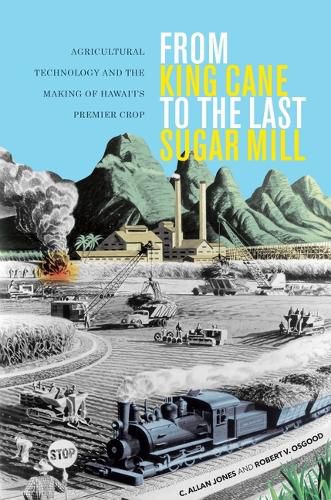Readings Newsletter
Become a Readings Member to make your shopping experience even easier.
Sign in or sign up for free!
You’re not far away from qualifying for FREE standard shipping within Australia
You’ve qualified for FREE standard shipping within Australia
The cart is loading…






From King Cane to the Last Sugar Mill focuses on the technological and scientific advances that allowed Hawai'i's sugar industry to become a world leader and Hawaiian Commercial & Sugar Company (HC&S) to survive into the twenty-first century. The authors, both agricultural scientists, offer a detailed history of the industry and its contributions, balanced with discussion of the enormous societal and environmental changes due to its aggressive search for labor, land, and water.
Sugarcane cultivation in Hawai'i began with the arrival of Polynesian settlers, expanded into a commercial crop in the mid-1800s, and became a significant economic and political force by the end of the nineteenth century. Hawai'i's sugar industry entered the twentieth century heralding major improvements in sugarcane varieties, irrigation systems, fertilizer use, biological pest control, and the use of steam power for field and factory operations. By the 1920s, the industry was among the most technologically advanced in the world. Its expansion, however, was not without challenges. Hawai'i's annexation by the United States in 1898 invalidated the Kingdom's contract labor laws, reduced the plantations' hold on labor, and resulted in successful strikes by Japanese and Filipino workers. The industry survived the low sugar prices of the Great Depression and labor shortages of World War II by mechanizing to increase productivity. The 1950s and 1960s saw science-driven gains in output and profitability, but the following decades brought unprecedented economic pressures that reduced the number of plantations from twenty-seven in 1970 to only four in 2000. By 2011 only one plantation remained.
Hawai'i's last surviving sugar mill, HC&S-with its large size, excellent water resources, and efficient irrigation and automated systems-remained generally profitable into the 2000s. Severe drought conditions, however, caused substantial operating losses in 2008 and 2009. Though profits rebounded, local interest groups have mounted legal challenges to HC&S's historic water rights and the public health effects of preharvest burning. While the company has experimented with alternative harvesting methods to lessen environmental impacts, HC&S has yet to find those to be economically viable. As a result, the future of the last sugar company in Hawai'i remains uncertain.
$9.00 standard shipping within Australia
FREE standard shipping within Australia for orders over $100.00
Express & International shipping calculated at checkout
From King Cane to the Last Sugar Mill focuses on the technological and scientific advances that allowed Hawai'i's sugar industry to become a world leader and Hawaiian Commercial & Sugar Company (HC&S) to survive into the twenty-first century. The authors, both agricultural scientists, offer a detailed history of the industry and its contributions, balanced with discussion of the enormous societal and environmental changes due to its aggressive search for labor, land, and water.
Sugarcane cultivation in Hawai'i began with the arrival of Polynesian settlers, expanded into a commercial crop in the mid-1800s, and became a significant economic and political force by the end of the nineteenth century. Hawai'i's sugar industry entered the twentieth century heralding major improvements in sugarcane varieties, irrigation systems, fertilizer use, biological pest control, and the use of steam power for field and factory operations. By the 1920s, the industry was among the most technologically advanced in the world. Its expansion, however, was not without challenges. Hawai'i's annexation by the United States in 1898 invalidated the Kingdom's contract labor laws, reduced the plantations' hold on labor, and resulted in successful strikes by Japanese and Filipino workers. The industry survived the low sugar prices of the Great Depression and labor shortages of World War II by mechanizing to increase productivity. The 1950s and 1960s saw science-driven gains in output and profitability, but the following decades brought unprecedented economic pressures that reduced the number of plantations from twenty-seven in 1970 to only four in 2000. By 2011 only one plantation remained.
Hawai'i's last surviving sugar mill, HC&S-with its large size, excellent water resources, and efficient irrigation and automated systems-remained generally profitable into the 2000s. Severe drought conditions, however, caused substantial operating losses in 2008 and 2009. Though profits rebounded, local interest groups have mounted legal challenges to HC&S's historic water rights and the public health effects of preharvest burning. While the company has experimented with alternative harvesting methods to lessen environmental impacts, HC&S has yet to find those to be economically viable. As a result, the future of the last sugar company in Hawai'i remains uncertain.